 Michel Gauquelin
Michel Gauquelin13 November 1928, 10:15 PM UT
Paris, France
Placidus Houses, True Node
Geocentric, Tropical
(Source Notes)
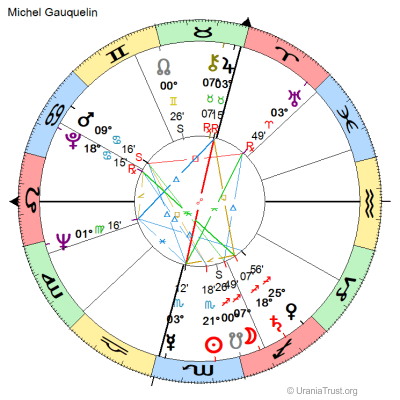
Michel Gauquelin was a French statistician who sought to establish whether or not astrology’s claims to describe human characteristics could be formally validated. While Michel believed in astrology from a young age his work ultimately challenged many of astrology’s claims, and in the long inter-disciplinary furor following the publication of his work neither astrology nor science acquitted itself well. The story is a long and complex one, and what follows is a partial and personal view, which for me begins with the last contact I had with him, one that was far from happy.
For much of his professional life Michel worked with his wife Françoise, whose work we shall also explore, but his initial discovery of how Mars was placed in the charts of champion athletes was his own discovery. In an article I attributed this finding to ‘the work of the Gauquelins’. The use of the plural resulted in a furious letter from Michel -how could I make such a mistake, how could I turn his discovery into a joint enterprise, didn’t I know what this meant for him, etc. etc.
As we had got on well for many years and he had stayed with me when in London, the letter shocked me to such an extent that I tore it up. It was some months before I finally sat down to write a reply, hoping to reclaim some former common ground, but I had left it too late. Michel killed himself in his apartment around 20th May 1991 for reasons that were never clear, though a failed relationship might have contributed to the outcome.
Something of a Background
Michel was born when the Sun was in Scorpio and the Moon in Libra, both lights being very evident in his life. Michel once described himself to Peter Roberts, a fellow researcher in astrology as ‘having a nasty streak within him due to the influence of Scorpio[i], though Roberts thought of him rather as having an ‘impish sense of humour’ and noted -as have others -Michel’s remarkable forbearance with his many detractors, some of whom had little grasp of the actual research or deliberately misrepresented it.
In reflecting on Michel’s life and work, Roberts described the ‘loss of a charming companion, a great intellect carried lightly and a dedication to truth which was truly exemplary’. I also saw much of that search for truth and, for the most part, an apparently light-hearted take on life, once suggesting to a conference that they invited him because of ‘my charming French accent’ -in this case delivered a la Maurice Chevalier. This side of Michel was also recognised by psychologist Hans Eysenck who wrote in his obituary:
Michel Gauquelin was a delightful person, witty, sociable and always ready to discuss his latest research. He was a sportsman, ranking at his best among the 50 leading tennis players in France. At many conferences we attended, we would play truant and go off to have a game on the red clay courts of France, Italy, Germany or Switzerland. Michel always seemed eminently stable, a tower of strength; he never lost his temper, however unreasonable his critics.[ii]
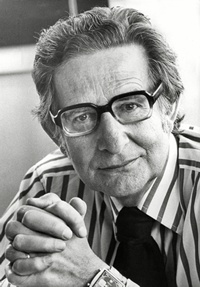
In commenting on Michel’s tennis ranking Eysenck touched on another aspect of Michel’s character, which Michel might also have attributed to his Sun sign: a ruthless dedication to towards achieving his goal. As a researcher Michel never spared himself effort; he was relentless in his pursuit of demonstrating the validity of his particular take on astrology. Even though he had been drawing up charts since his catholic school days, where he was once punished by a priest who overheard the eleven-year-old Michel asking a girl if she was a virgin (which in French is a synonym for Virgo), Michel recognised from the outset that his findings were at odds with the tradition that he had originally practiced. Nevertheless, he expanded his work[iii]. In her reflection on Michel’s life Erin Sullivan wrote:
Gauquelin felt that the true astrological meaning had been obscured, largely by Ptolemy’s epicycles for a span of 1800 years. He felt that he himself might penetrate the veil and launch a new Copernican revolution in astrology by going back in time to re-discover a lost factor, which he demonstrated as being operative in the ‘Mars Effect’[iv].
So, what is the ‘Mars Effect’ and why did it stir up so much controversy?
Mars: The God of War
Though there have been endless battles over Michel’s various research findings, the core of the Mars Effect is remarkably simple; it has nothing to do with what sign you are or even on what day you were born. All that is needed is the place and time of birth. From this we can graph how the planets were seen in the sky at the time of birth. From our perspective the Sun, Moon and all the planets revolve around our planet.
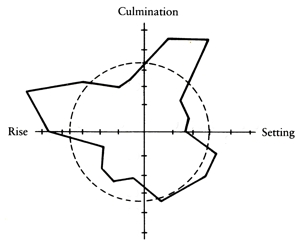
Each day they are first seen on the eastern horizon, then they culminate above us, and then set in the west. Gauquelin’s research used the birth data of champion athletes to demonstrate that they tended to be born when Mars was around 10 degrees above the eastern horizon, or a similar amount after the culminating point, with a lesser effect around the western horizon and at the anti-culminating point. In the case of the 1485 champion athletes this distribution went against chance by some 1:5 million[v]. Further examples will be discussed below.
One might think that plotting the position of a planet in what astrologers call the diurnal circle (the daily rhythm of the apparent motion of the planets around the earth) is a simple one, but such is not the case. Before induced births became common practice - which applies to the vast majority of the birth data he used - there was a slight tendency for birth to occur nearer dawn and, owing to the Sun/Mars relationship, there is a greater than average chance of Mars also being near the Sun and thus in the important eastern zone discovered by Michel.
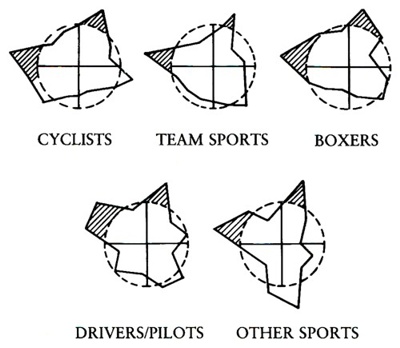
The calculations are considerable and a very clear understanding of statistical probably is required; most of these calculations were carried out by Michel before a computer was available. All in all, the scope for questioning his work is appreciable and from the moment of its initial publication a perpetual, hostile cross-examination was carried out ferociously, and at times dishonestly by his critics.
The Response of Science
In 1975 September/October edition of The Humanist journal carried an advertisement signed by 186 scientists denouncing astrology, perhaps prompted by the increased awareness of Michel’s work. Interestingly, apparently none of these 186 scientists had read any research on the subject, and for this they were strongly criticised by one of the world’s foremost scientists, Paul Feyerabend. Feyerabend, a leading philosopher of science, asked how any scientist could reject something they had not studied or oppose a different perspective because it did not fit into a pre-established paradigm[vi].
Alas, his words did not resonate within the scientific community, as became evident when Michel’s work by scrutinised by the then-named Committee for the Scientific Investigation of Claims for the Paranormal (CSICOP). For a so-called group of scientists, they managed to get just about everything wrong. There were constant arguments between committee members, thousands of charts calculated erroneously, attempts to replicate (i.e. refute) Gauquelin’s findings using the birth date of ordinary athletes rather than acknowledged champions and so on. This led to one committee member Dennis Rawlins to throw up his hands in despair at all the non-scientific shenanigans and publish a full account entitled sTarBaby[vii] .
This tumult ultimately resulted in CSICOP abandoning any further attempts to engage with ‘paranormal’ phenomena and indeed to change their name to the Committee for Sceptical Enquiry as a consequence of much international scorn and mockery. One might have thought that this example would make other researchers more (genuinely) sceptical of how best to go about replication, but such was not the case. As Suitbert Ertel and Kenneth Irving have put it in their history of Gauquelin’s work, The Tenacious Mars Effect:
Though the CSICOP case in the US probably resulted in the widest scandal, three other ‘rationalist’ committees have been involved, two of which were in Europe. At each stage of the controversy, a committee would study the issue and then publish deceptive or incomplete conclusions which would then become the basis for the next committee’s attack on the Mars effect[viii].
While this brief quote sums up a typical attitude to Michel’s work it is but a fraction of what The Tenacious Mars Effect contains. Authors Erbert and Irving offer a scholarly account of virtually every stage of Michel’s work, containing every important attempt at replication, every response to every serious criticism, together with copious notes on the personnel involved, their letters, their pertinent (or impertinent) comments, the statistics and graphs of the dozens of different samples: in short, a remarkable and comprehensive account of Michel’s work, which it confirms and validates. Altogether it is hard to imagine that anything further can be said; and yet…
Life Beyond Mars
Thus far we have looked at the impact of Michel’s Mars studies, but this is only the beginning of the story. For a start, the distribution of that planet in the diurnal circle has been demonstrated to change slightly when different categories of sports champions are used. For instance cyclists, boxers, racing drivers and so on have distinct distributions of their own, some of which tend towards a three fold pattern rather than the classic four fold -though in virtually all cases the ‘key sectors’ (above the horizon and just beyond the culminating point) are essentially consistent.
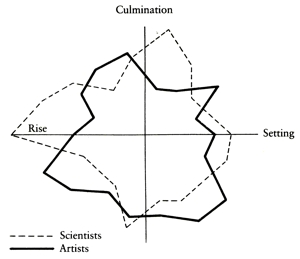
This might suggest that the various forms of athletic excellence have their own particular signature, perhaps reflecting the differing qualities of the participants. More importantly, the same phenomenon can be seen in other groups when the planets traditionally associated with an occupation are plotted in the same manner. Jupiter scores high in the key sectors for politicians and actors (spot the differentness some might say) Saturn for scientists and the Moon for journalists. Furthermore, just as scientists have Saturn in the key sectors, artists do not. What is strong in one occupation can be weak in another, representing the different skills required -or more importantly, the different characteristics or desires of the native.
It is at this point that we can also consider looking at the data from a more psychological perspective. While success in a field remains important -often referred to as the ‘eminence effect’ -what drives someone to excel at sports might also be found in the charts of successful business people. If an individual is consistently referred to in biography or obituary as forceful, dynamic, a go-getter etc. that person is likely to have Mars in one of the key sectors, which research has confirmed. As Hans Eysenck commented:
Another important finding was that personality seemed to be involved in planetary effects. There appeared to be a “typical” personality characterising most sportsmen, different from that characterising, say, of scientists, or actors – planetary effects were apparent only for those sportsmen, scientists or actors with the right kind of personality. Thus extroverts tended to be born under Mars, introverts under Saturn.[ix]
In a similar manner, the number of citations found in biographical dictionaries and established works of reference can be used as an indicator of eminence in a particular field, which is often demonstrated with the appropriate planet in key sectors. In one German study of 230 students who were graded according to a standard personality test it was found that those with Jupiter in a key sector scored higher in extraversion compared to those with Saturn angular[x].
While these are just samples from extensive research projects Michel was committed to discovering more than statistical correlations: his question was why is this happening? In seeking a scientific basis for these phenomena, he explored sun spot cycles, solar radiation, geomagnetism (which in part is influenced by the position of the Moon and the major planets) as well as exploring possible hereditary effects within families that demonstrated intriguing similarities, raising questions regarding genetic effects or the consequences of magnetic influence on the gestating foetus. The astronomer Percy Seymour explores some of these ideas in his book The Scientific Basis of Astrology[xi] which also outlines a number of natural cycles known to influence various life forms.
Another dedicated researcher who has explored the Gauquelin data at some length is Graham Douglas. His approach considers geomagnetic influences and lunar cycles, re-plotting the original findings in relation to planetary cycles, particularly Jupiter/Saturn, noting the significance of solar activity at conception, longevity and creativity in the 27-day solar rotation cycle, re-examining the birthday in cases of Sudden Infant Deaths, and noting possible connections between Michel’s graphs and the more traditional astrological style. His work can be found in the Astrological Association’s research Journal, Correlation[xii].
Here it should be noted that while the Astrological Association has always been at the forefront in publishing the work of the Gauquelins and in organising research conferences giving prominence to their findings, astrologers themselves have been somewhat lukewarm as to its significance. This is in part due to the fact that it does not confirm traditional perspectives and is thus seen as being unhelpful, and that at times it directly contradicts long-held beliefs. For example, a planet in the 12th house of a natal chart is often viewed suspiciously, seen as bringing about the ‘self-undoing’ of the native. In fact, a planet in this placement is in a key sector in Michel's findings, statistically indicating the quality most likely to correlate with the native’s success.
Similarly, the four and three-fold patterns that consistently emerge in Gauquelin’s diagrams offer some support for John Addey’s work in harmonics; again, a forward-looking approach that most astrologers ignore. However, not all are reluctant to accept the challenge of Michel’s findings. In his reflection on Michel’s research scientist and astrologer Peter Roberts wrote:
It will stand comparison with the work of the best scientists of this century, though Michel himself points out that there is a further chapter to be written. In the same way that Copernicus laid the foundation and Kepler followed with the laws of planetary motion, it was not until Newton that a comprehensive theory emerged and all parts of the jigsaw could be fitted together, so we await a 20th or 21st century Newton who can explain in one overarching theory how the Gauquelin results in relation to profession, personality characteristics and heredity are all parts of one scheme[xiii].
In the meantime, there are still some prominent astrological researchers who have contributed to developing these ideas, some of which have published their findings in the journal Astro-Psychological Problems, edited by Michel’s former wife Franҫoise Gauquelin.
The Work of Franҫoise Schneider-Gauquelin
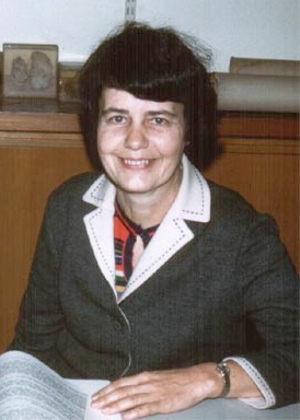 Françoise Schneider-Gauquelin
Françoise Schneider-Gauquelin19 June 1929, 4:00 AM CET
Neuchâtel, Switzerland
Placidus Houses, True Node
Geocentric, Tropical
(Source Notes)
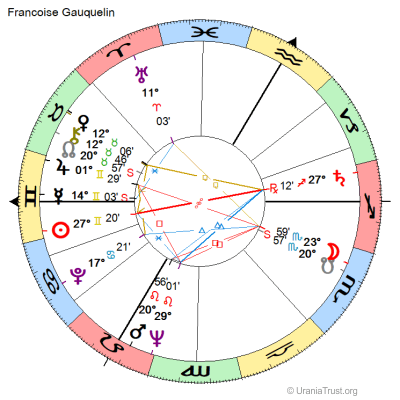
Franҫoise Schneider was born on 19th June 1929 at 4:00am in Neuchâtel, Switzerland with her Sun in Gemini and her Moon just two degrees away from Michel’s Sun in Scorpio. A psychology graduate, she met Michel in 1952 following the publication of his initial work and later became an active collaborator in their joint project of collecting tens of thousands of birth certificates of various groups for computer analysis. After their marriage ended in 1982 Franҫoise created and edited her own journal Astro-Psychological Problems, a title that was deemed by some most appropriate given that it required a very tactful conference facilitator to keep Michel and Franҫoise apart during their presentations.
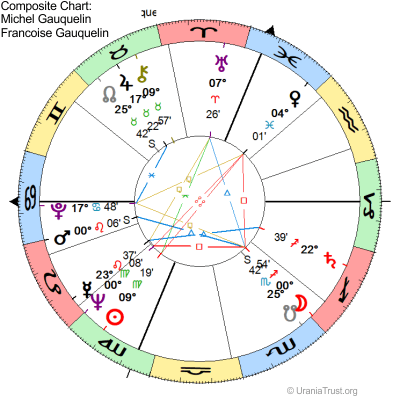
The journal’s aim was to invite a wide range of submissions primarily focused on plotting planets in the diurnal circle, though it also included planets in signs, tables of time-changes, discussions on theoretical matters, critical responses and letters. Altogether it was an ecumenical publication which carried research articles on such topics as sexual orientation, the Gauquelin sectors for ‘ordinary’ people, the charts of marriage partners, of terrorists, explored planetary heredity, traditional aspects vs the Gauquelin data, traffic accidents, murderers, drug addiction and so on. While several of the articles drew on relatively large samples, some were quite small and had their own contributions to make. For example, one Dutch astrologer had the birth data for five generations of a farming family. In each successive generation the farm was inherited by the son deemed to have the best leadership qualities. In every case it was later found that this son had Jupiter in a key sector[xiv].
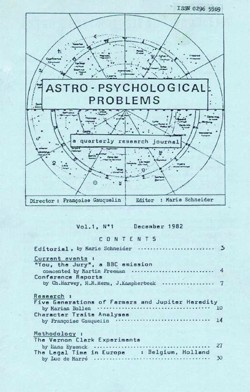
Astro-Psychological Problems continued to be published until 1995 when health problems curtailed Franҫoise’s prodigious energy and output. She died on 10th August 2007. In his reflection on her life and work Kenneth Irving recalled a conversation in which Franҫoise wondered whether Suitbert Ertel thought of himself as Michel’s successor, to which Irving replied ‘we are all Michel’s successors’. After a pause, she smiled and said ‘you’re right’.[xv]
While this may be true in terms of the legacy of the Gauquelins, it has to be acknowledged that apart from a few dedicated researchers, very little has been done to advance their work. Eysenck and Nias may claim that ‘perhaps the time has come to state quite unequivocally that a new science is in the process of being born’[xvi], but one that has little impact on how astrologers think and work. This may in part be due to the fact that many of the Gauquelin’s strongest supporters such as John Addey, Charles Harvey, Peter Roberts, Suitbert Ertle amongst others are no longer with us, but also - paradoxically- just as science is reluctant to address findings that challenge dogma, so it goes with the vast majority of astrologers. Sadley it would appear that those who have been bequeathed what Eysenck and Nias call a ‘nugget of gold’[xvii] have done little with their inheritance.
Mike Harding ADEP, D.FAstol.S.
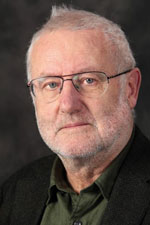
Mike Harding spent many years as a Faculty Council Member in the Faculty of Astrological Studies, and was Director of the Faculty’s Counselling Within Astrology course. He is also a past chairman of the Astrological Association of Great Britain and of the Association of Professional Astrologers. He worked together with Charles Harvey for many years, primarily in business and mundane astrology and wrote with Charles the invaluable book 'Working with Astrology'. Mike is also author of 'Hymns to the Ancient Gods' and of numerous articles for various astrological publications. Currently, Mike is working as an existential psychotherapist and is Chair of the Society of Existential Analysis. He is interested in the cross-over points between psychoanalysis, existential practice and the ancient wisdom traditions. Mike is also a Course Leader, Foundation Programme, at Regent's University London in Humanities & Social Sciences. (Photo: Regent's University.)
Endnotes
[i] The Independent newspaper, 20 June 1992
[ii] See Correlation, Vol. 11, No. 2, June 1991
[iii] Interestingly, though Michel’s work did not confirm traditional signs, he ascribed one of his characteristics to his Scorpio sun. On another occasions, when his plane was delayed he said this was what happened with a Saturn transit. Just what an astrologer might say.
[iv] Correlation, ibid
[v] Gauquelin, M. Written in the Stars, The Aquarion Press, 1988, page 111
[vi] Feyerband, P. The Strange Case of Astrology in Science in a Free Society, London. 1978
[vii] http://cura.free.fr/xv/14starbb.html accessed 11 August 2025
[viii] Suitbert Ertel and Kenneth Irving, The Tenacious Mars Effect, The Urania Trust, London,1996, page K1-14
[ix] The Independent Newspaper, ibid
[x] Astro Psychological Problems Vol10.1, March 1994
[xi] Seymour, P The Scientific Basis of Astrology, Quantuum Books, 1997
[xii] Douglas, G. in Correlation Vol 24(1) 2006, Vol 35(1) 2007, Vol 25(2) 2008, Vol 26(1), Vol33 (1), Vol 33 (2) 2021 and Vol 37(2)
[xiii] Roberts, P in Correlation Vol 11 (1) June 1991
[xiv] Astro Psychological Problems Vol10.1, March 1994
[xv] Correlation, Vol 26(1) 2008
[xvi] H.J.Eysenck & D.K.B.Nias, Astrology, Science or Superstition? Temple Smith Books 1982,, page 209
[xvii] Ibid, page 209.
